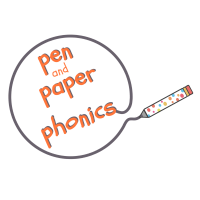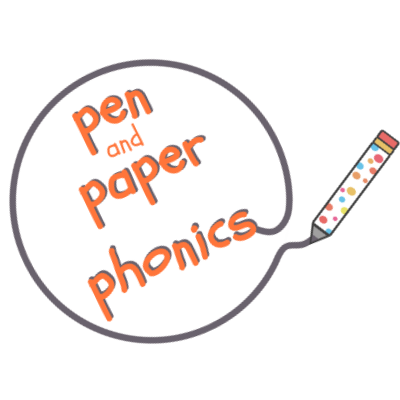
The ‘Magic E Rule’ is a great phonics rule for children to learn. Once learned, it opens up a huge amount of new words that can be read independently.
This Snakes and Ladders game helps to teach and reinforce how to read words that use this rule. It is a fun and interactive game that can be easily adapted to suit the individual child.
Jump straight to the free printable downloads
Magic E Background Information
The Magic E goes by many names – Super E, Ninja E, Final E, Silent E, Sneaky E and just plain old ‘split digraph’. But whatever you call it, it’s a good rule to know.
The rule teaches that the ‘e’ at the end of a word, such as ‘same’, changes the sound of the first vowel in the word – it makes it a long vowel sound.
So, for example in the word ‘same’, the ‘e’ is making the ‘a’ say it’s name (/ā/ as in ‘acorn’) rather than it’s sound (/ă/ as in ‘apple’)
Another example would be the word ‘rid’. ‘Rid’ becomes ‘ride’ when the ‘e’ is added – the ‘e’ is not making a sound, it is just changing the sound of the vowel ‘i’.
Often children start with regular CVC words, such as ‘rid’ or ‘can’ and practice adding an ‘e’ to it to make a new word: ‘ride’ or ‘cane’.
The Basic Idea for this Magic E Snakes and Ladders Game.
The idea of this game is the same as the classic Snakes and Ladders Board Game. Word cards are arranged in a grid, and ladders and snakes are placed around the grid. As each player moves along the grid, they read the words they pass.
The word cards are easily moved, changed and adapted so that the game can be repeated often. It can therefore be made easier or more difficult, according to the student’s needs.
*If you would like help to know if this ‘Who Has It?’ activity is right for your child or student, click here for information to help you decide.
Magic E Snakes and Ladders
What you will need:

- Small, regular sized cards,
- A list of words that use the ‘magic e’ rule,
- Two ladders and two snakes, made from card (or pipe cleaners),
- A dice
- Two counters or cubes.
*In the resources section of this post, there are some free magic e sound word lists, printable sets of words cards, and printable snakes and ladders.
How to play the game:
- Make – or print out – the word cards. Arrange them in a grid. Put a start and finish card at either end of the grid.
- Arrange the ladders and snakes at various points on the grid. Both ends of the ladders and snakes need to touch a word card.

- Put the two counters at the start. Then take turns to roll the dice and move along the grid. Read each word as you pass over it. So for example, if you roll a four, you will read four words.
- If you land on a ladder you can move up to the top and land on a new word. If you land on a snake, you go down and land on a new word.
- Keep going until one or both of you reach the finish card.
- You can rearrange the order of the words, or add new words in and play again.
To Note
Not every game or activity goes to plan! Here are some things to watch out for:
- I only use two ladders, as too many ladders makes the game very short!
- Because in a normal game of snakes and ladders the person is just moving their counter, I often have to reiterate the need to read the word as the student passes over it. This takes a few reminders but often, after a few games, it comes naturally.
How to Adapt

Take it Outside: You can easily take this game outside by writing the words in chalk, in a grid form, and drawing on the snakes and ladders. Then use yourselves as the counters and as you move, read the words you step on.

Decrease the difficulty of the words: For example, only use one vowel sound. This would be a good idea if your child has just started to learn about the magic e. A good order to do this in is to start with words that use ‘a’ (name, made), then ‘i’, then ‘o’, then ‘u’, and finally ‘e’. To make it even simpler, use words with the same ‘letter string’ such as ‘name’, ‘game’, ‘same’, ‘came’ and ‘fame’.

Increase the difficulty of the words Use words with blends or digraphs in them, such as ‘frame’ or ‘crane’ (there’s some word lists for this in the free resources section below).
Here’s how it looked when I did it in ‘real life’!

Resources
Printable Resources:
Related Content:
Magic E is a split digraph – it is two letters making one sound, but they are not next to each other. The following posts are about words that use digraphs:
You might like this you tube song is a fun way of introducing the magic e sound.
Is this Magic E Snakes and Ladders game right for my child?
Sometimes, it can be difficult to know if an activity will be helpful for your child or student. For this activity, the questions below might help:
- Does your child know the letters of the alphabet, and the sounds they make?
- Can they sort letter flashcards into vowels and consonants?
- Can they give the name and sound of each vowel? For example ‘a’ says /a/.
- Have they started to learn that one sound can be represented by more than one letter. For example that ‘ck’ makes one /k/ sound?
- Have they begun to read words with two letter sounds in them? For example ‘check’, ‘this’ and ‘shed’.
- Are they reading simple sentences, made up of one syllable words, when reading a book?
If the answer is ‘yes’ to these questions, then this ‘Magic E Snakes and Ladders’ activity will be a great way to teach or reinforce the Magic E Rule.





